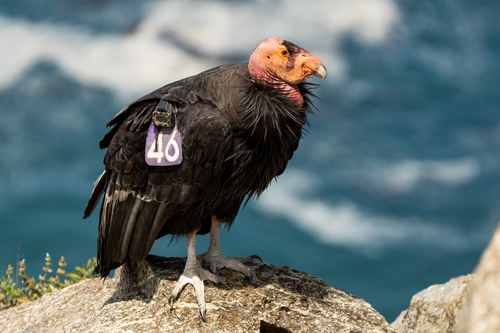
California Condor
The California Condor (Gymnogyps californianus) is a critically endangered New World vulture and the largest North American land bird. Once on the brink of extinction, with only 27 individuals remaining in the wild in 1987, it has become a symbol of successful, albeit intensive, conservation efforts. This majestic bird plays a vital role as a scavenger, cleaning up carcasses and helping to prevent the spread of disease. It holds cultural significance for some Native American tribes, often featuring in traditional stories and ceremonies.
109-134 cm
Length
249-300 cm
Wingspan
Critically Endangered
Conservation Status
Distribution
Historically, California Condors ranged from British Columbia, Canada, down to Baja California, Mexico, and eastward to Arizona, Utah, and Wyoming. Currently, reintroduced populations exist in California (Big Sur, Pinnacles National Park, Los Padres National Forest), Arizona (Grand Canyon), and Baja California (Sierra de San Pedro Mártir National Park).
Lifespan
Up to 60 years in the wild; potentially longer in captivity.
California Condor's Habitat
Habitat Types
Rocky shrubland, Coniferous forests, Oak savannas
Climate Zones
Temperate, Mediterranean
Adaptations
Condors require large, open territories with cliffs or tall trees for nesting and roosting. Their broad wings are adapted for soaring on thermals, allowing them to cover vast distances in search of food with minimal energy expenditure.
Variations
No recognized subspecies exist.
Appearance
Breeding Plumage
Adult plumage is predominantly black with white patches under the wings. The head and neck are largely featherless, with skin color ranging from reddish-pink to yellow, which can change with the bird's emotional state.
Seasonal Feather Changes
No significant seasonal variation in plumage color, but skin coloration on the head and neck may vary.
Sex Based Plumage Differences
Males and females have similar plumage.
Notable Features
Large size and broad wingspan, Featherless head and neck, Prominent white wing patches, Hooked beak
Diet and Feeding
Primary Foods
Carcasses of large mammals (deer, cattle, sheep, etc.), Carcasses of marine mammals (whales, seals) along the coast
Foraging Behavior
California Condors are obligate scavengers, relying entirely on carrion. They soar high above the ground, using their keen eyesight to spot carcasses. They often feed in groups, with dominant individuals feeding first.
Specializations
Their featherless heads prevent soiling while feeding inside carcasses. They have a strong stomach acid that allows them to safely consume decaying meat that may contain harmful bacteria.
Seasonal Diet Variations
Diet may vary slightly depending on the availability of carcasses, which can be influenced by seasonal migrations of prey animals or livestock management practices.
Behavior
Social Structure
California Condors are generally social, often feeding and roosting in groups. A dominance hierarchy exists within these groups, with older, more experienced birds typically dominating.
Communication
Hisses and grunts, Visual displays (head and neck coloration changes), Body postures (wing spreading, head bobbing)
Migration
California Condors are not migratory in the traditional sense, but they may travel long distances within their home range in search of food.
Territorial or Group Behaviors
Condors do not defend a specific territory in the way that some other raptors do, but they will defend feeding sites and roosting areas from competitors.
Conservation
Threats
Lead poisoning (from ingesting bullet fragments in carcasses), Habitat loss and degradation, Historical persecution (shooting and egg collection), Collisions with power lines, Microtrash ingestion
Protection Programs
Captive breeding and reintroduction programs, Lead ammunition education and outreach, Monitoring of wild populations (radio telemetry, GPS tracking), Habitat restoration and protection, Treatment of lead-poisoned birds
Local National Laws
Protected under the U.S. Endangered Species Act, the Migratory Bird Treaty Act, and California state laws.
Population Trend
Increasing
Population Estimates
Approximately 561 birds total (wild and captive) as of December 2023. Approximately 347 of these are free-flying.
Interesting Facts
They can fly to altitudes of 15,000 feet (4,600 meters).
This allows them to take advantage of thermals and cover large areas in search of food.
They can go for several days without eating.
This is an adaptation to their scavenging lifestyle, where food availability can be unpredictable.
Condors can consume up to 3 pounds of food at a time.
Then can then store this food in their crop.
Faqs about California Condor
Why were California Condors almost extinct?
A combination of factors led to their near extinction, including lead poisoning, habitat loss, shooting, and egg collection.
What is being done to help them recover?
Intensive conservation efforts, including captive breeding, reintroduction, lead reduction programs, and habitat protection, are helping the population recover.
Can I see a California Condor in the wild?
Yes, it is possible to see them in their reintroduced ranges in California, Arizona, and Baja California. National Parks and other protected areas offer the best viewing opportunities.
Are California Condors dangerous to humans?
No, California Condors are scavengers and pose no threat to humans. They are generally shy and avoid human contact.
Copyright @ Nature Style Limited. All Rights Reserved.
 English
English